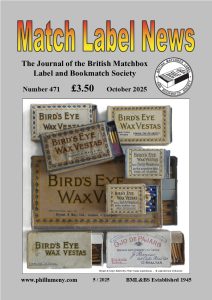Ephemera Society Summer Fair : 29th May
Our friends at the Ephemera Society are holding their Summer Fair on 29th May. Full details can be found here on their web site.
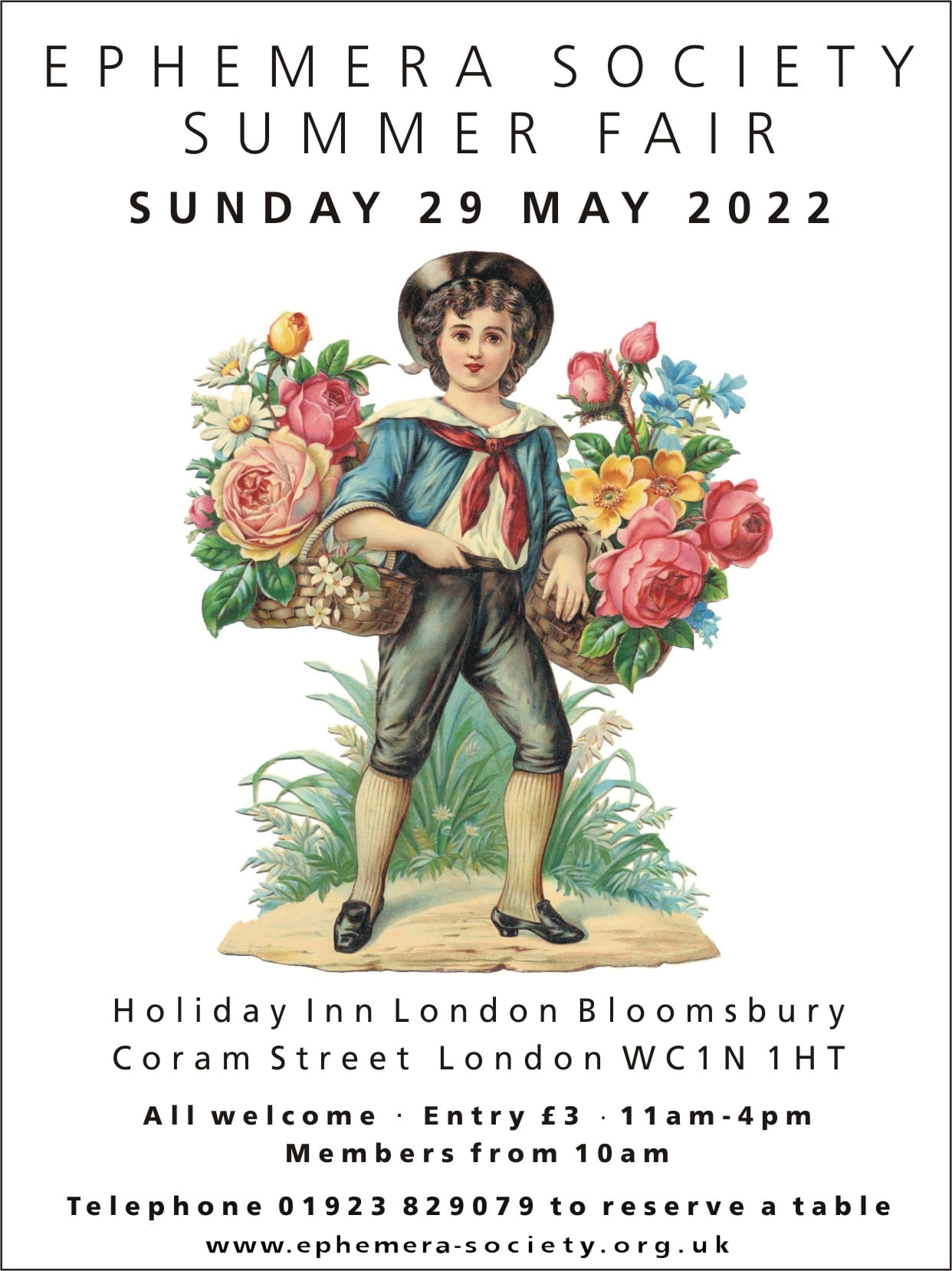
Our friends at the Ephemera Society are holding their Summer Fair on 29th May. Full details can be found here on their web site.

The June magazine has now been posted to members, which includes all the latest information about Phillumeny, all Society Events and the forthcoming Society Auctions.
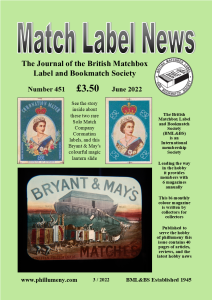
A new book has just been published called Striking! Advertising Matches from Singapore which can be purchased here.

With its rectangular and pocket-friendly form, matchboxes plastered with advertisements once offered an affordable and portable means of marketing for restaurants, hotels and other businesses. This collection of over 350 covers from Singapore—each reproduced true to size—captures the city-state’s colourful modernisation during the 1970s to 1990s. An accompanying essay on the history of matchbox production in Singapore along with seven curated themes reveals the many meanings and cultures emblazoned on each design.
A full review will be published in our August magazine.
Read what Visitors to our 2024 On-line Exhibition thought of the show.
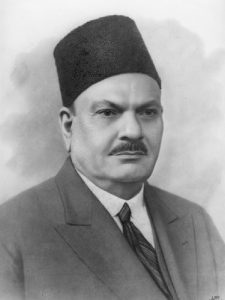
President’s Award winner 2022
Exhibitor : Badrul Hisham Jaafar
This exhibit is dedicated to the match labels of a famous entrepreneur and industrialist who is one of the founding fathers of Pakistan: Sir Adamjee Haji Dawood (1880-1948).
Born in 1880 in Jetpur, Gujrat, British India of a Memon community, Sir Adamjee began his entrepreneurial venture very early in life when he was just a teenager. His real name is Adam Dawood Baig Mohammad. He was fondly called Adamjee by his mother where the suffix ‘jee’, sometimes spelled ‘ji’, denotes special affection in Gujarati family. He went to Burma (now Myanmar) in 1895 at a tender age of 15 to work as an apprentice. By the age of 18, he had begun operating his own business. In 1914, his company, Adamjee Dawood & Co was established and traded items such as rice, jute, and matches amongst others. In 1920 he built his own match factory in Rangoon which began match production by December of 1923.
This is a story of rags to riches, of mercantile to conglomerate, of a commoner to a national hero. Such a story deserves to be told and retold. As such, this exhibit intends to share part of his legacy by focusing on the match labels, a trade Sir Adamjee started off, amongst many of his joyous and arduous journey as an entrepreneur, a social visionary and philanthropist. Sir Adamjee was knighted in 1938 by the British Government due to his immense contribution to society such as his active involvement in flood relief activities and education related ventures amongst many others in British India.
Imported brands of Adamjee’s matches from Japan.
Adamjee’s match factory was reputed to be amongst the largest in Asia of its time, located in Pazundaung, Rangoon (Yangon) hired 1,400 employees mostly consist of Burmese women. His industrialization dream bears witness to a successful match manufacturing venture using German and Japan made machines. The business survived various episodes of hardship particularly the famous match trade war between Adamjee and the “match king” Ivar Kreuger of Swedish Match Company (SMC) who owned nearly 75 percent of world match trade at the time. It also survived the 1938 bloody riots of Burma and the 1942 Second World War. However, the factory was subsequently nationalized by the Burmese state in 1968.
Manufactured brands of Adamjee’s match labels from Burma (Myanmar). It was reported that Adamjee had over 2 dozen match label brand names manufactured out of his factory in Rangoon.
These labels now bear witness to the legacy of a business conglomerate, the Adamjee Group and the man himself for his contribution in the early formative days of Pakistan as a country. A successful entrepreneur extraordinaire, Sir Adamjee is remembered as a person who helped fund the newly created Pakistan by providing “a blank cheque” secured by his personal assets during Pakistan’s critical formative years.
This is a tribute towards a personality who not only made a name in match trading and match manufacturing in Asia but also towards humanity, industrialization and social development. Sir Adamjee, a commoner turned national hero born out of a match industry.
* denotes estimated years.
All information is duly obtained from exhibitor’s personal reading of related information referred to and obtained from :
I) “Colonial Burma, history and phillumeny” by Andrew Selth, 24thMay, 2016 published in the New Mandala, (www.mandala.org)
ii) “The Merchant Knight – Adamjee Haji Dawood”, by Daleara Jamasji-Hirjikaka & Yasmin Qureshi, Adamjee Foundation, 2004.
iii) “Adamjee Haji Dawood” on wikipedia.com
Click here to return to the Gallery.
President’s Award winner 2021
Exhibitor : Badrul Hisham Jaafar
This exhibit focuses on the Tiger theme of match labels manufactured or used in the Federated Malay States, Malaya and Sarawak (all part of Malaysia). It is reported by the World Wildlife Fund (WWF) group that the Malayan Tigers are so endangered with less than 300 Malayan Tigers in the world of which only about 200 left in the wild. Let’s save our beautiful endangered tigers while enjoying the artistic match label designs of yesteryears.

The red coloured tiger label on the right is reputed as the first ever locally manufactured match brand of 1922 by the Malayan Matches Ltd of Selangor in the Federated Malay States (FMS). Prior to this all matches in Malaya were imported by local traders, particularly from Sweden, Great Britain, Japan, China and others. The tiger image has similar resemblance to that of a Malaya postage stamp. After enquiring, I realised that it was a matchbox label but unfortunately it was not for sale – it was the shop owner’s favourite and he was keeping it for himself. Some things, money just could not buy. To be honest, I didn’t dare to make an offer anyway. To me that’s an example of real love; an attachment.
That fateful event was the start of my eventual journey into phillumeny. After some years, I managed to acquire this beautiful red tiger label from a French collector. The rest, as they say, is history.


Tiger is a famous and important theme for Malaya. Evidently, it was used as a brand to symbolise courage and strength.
In 1933, Kelantan Match Factory (KMF) was established and interestingly, the company, still produces matches in Kota Bahru, Kelantan till this very day.
It has a reputation as one of the most prolific and famous local match manufacturers. Tiger Head and Two Tigers are two of KMF’s brands, more are shown in the gallery below. Various other tiger labels from KMF and variants do exist.
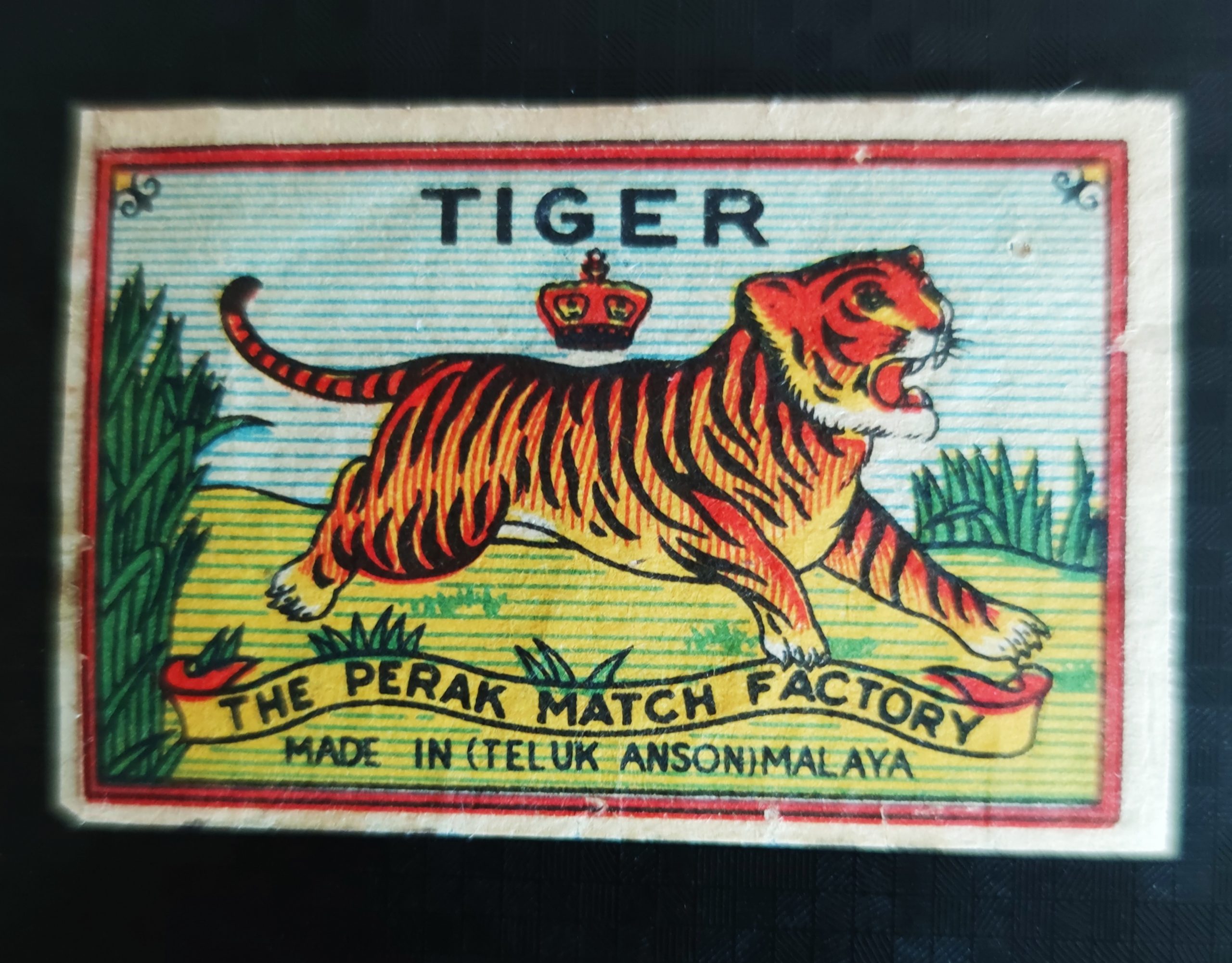
Back in the old days, rumours were rampant that Britain’s Bryant & May was considering a manufacturing set up in Perak, Malaya to take advantage of the abundance of wood and the new hydro-electric infrastructure. The rumours remain unrealised.
Instead, in 1936, the Perak Match Factory (PMF) was established. Their early label designs are quite similar to Kelantan’s KMF as they share common shareholders.
In late 1940s, Sarawak Match Factory was established in East Malaysia but ceased operation sometime in the mid-1960s.
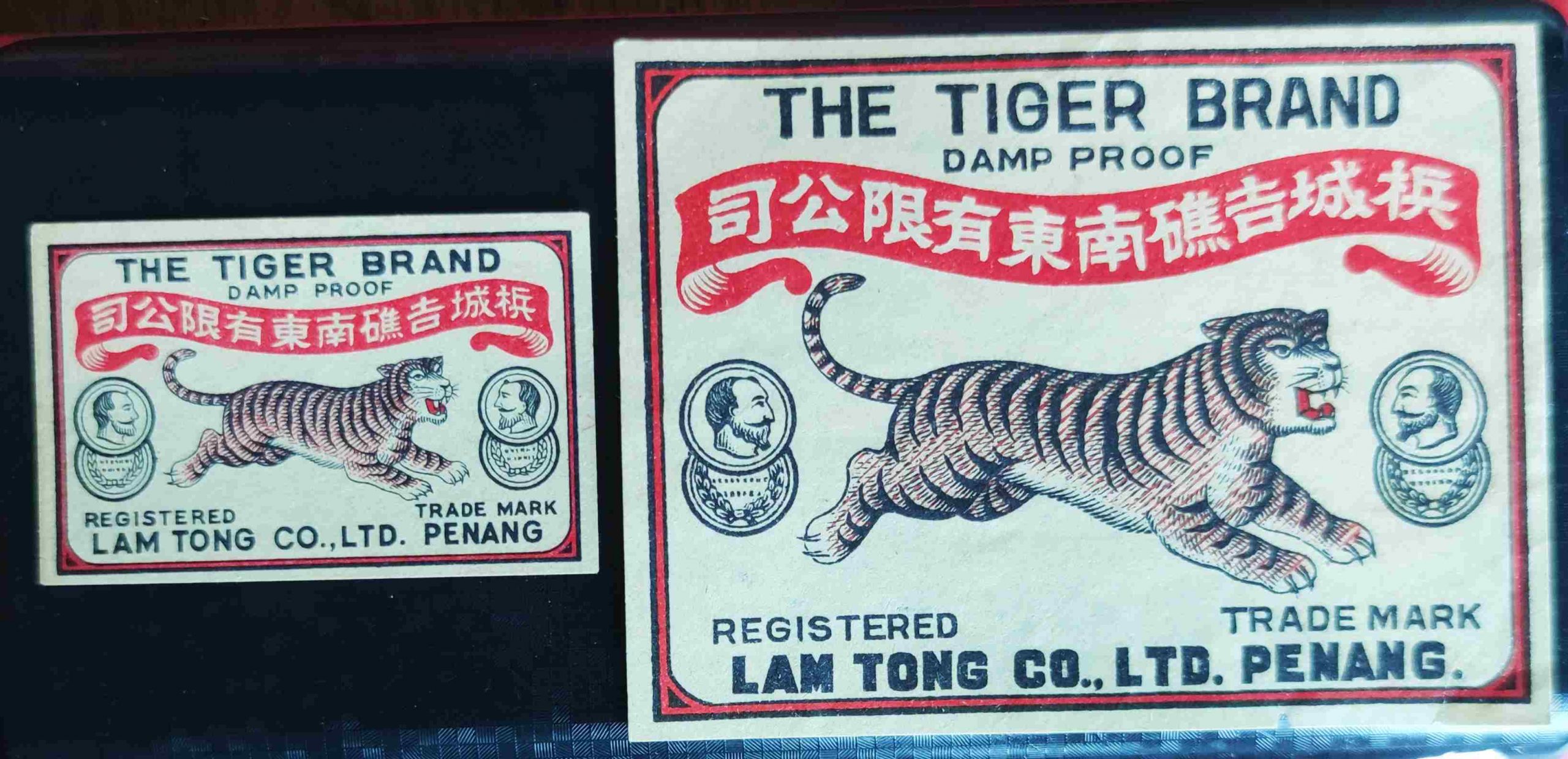
Imported matches were also in abundance and Penang’s Lam Tong is one such fine example. The matches were imported from Hong Kong.
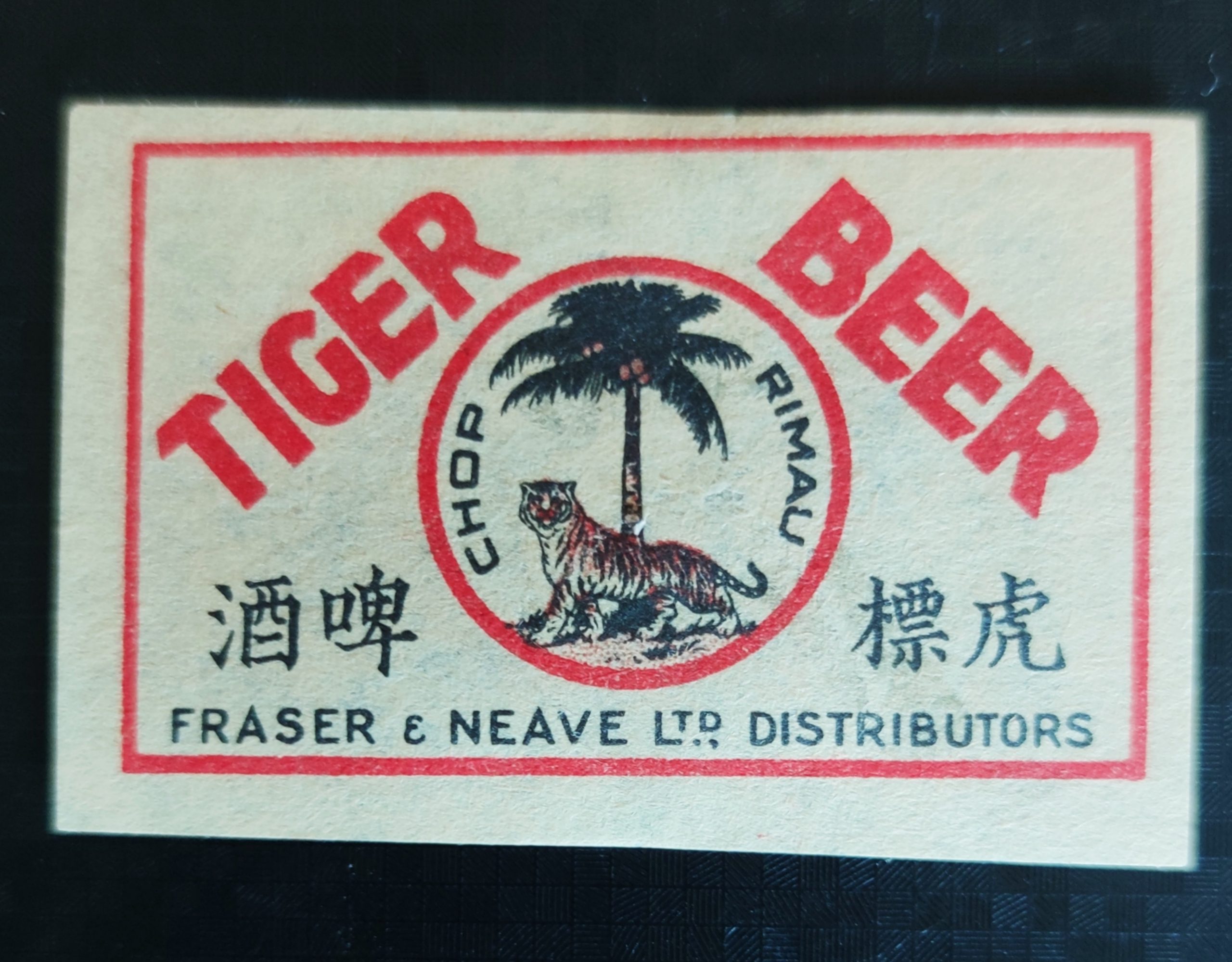
The tiger is considered an iconic brand for various products. One particular example is the Tiger Beer. On the right is a matchbox advert for Tiger Beer by Fraser & Neave Distributors (F&N) branded locally as Chop Rimau (the word “Chop” means brand while “Rimau” a shorten form of “Harimau” or Tiger in Malay language).
Some more Tiger labels are shown below, click on an image to enlarge it.
[Not a valid template]Click here to return to the Gallery.

Committee’s Award winner 2023
Exhibitor : Joel Viana de Lemos

Click here for Portuguese language version
On July 8th, 1497, a fleet of three sailing ships left Lisbon – the S. Gabriel, the S. Rafael and the Bérrio – and a small ship with supplies. The fleet was commanded by the Portuguese navigator Vasco da Gama and aimed to discover the maritime route from Europe to India.
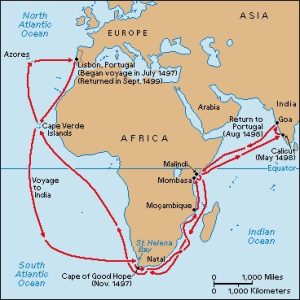
On May 17th, 1498, the fleet reached Kappakadavu, near Calicut, in the present Indian state of Kerala.

In addition to the important trade relationships it established, Portugal maintained a permanent presence in the state of Goa for around 450 years, until 1961.
.

The most important match factory in Goa was the Companhia Fosforeira de Goa, LDA
Some of the matchboxes produced by this factory can be seen below.
Note: On each label and matchbox are indicated the references of the “Catálogo das etiquetas de caixas de fósforos – Portugal / Catalogue of Portuguese Matchbox labels” published in 1996 and 2013 and on the last four labels the references of the Swedish catalogue “Katalog över Svenska Tändsticksetiketter” published by Arne Tejder in 1963. Measurements refer to the printed area and are in millimetres.
A few labels are also known from other factories in Goa.
The Gallery below shows all the known matchbox labels produced in Goa. Click on an image to enlarge it.
The following packet labels are from Companhia Fosforeira de Goa:
The Gallery below shows two matchbox labels and their respective packet labels, made for matchboxes which were exported to Goa by the Swedish factory Jönköpings Westra Tändstickfabrik.
Click here to return to the Gallery.
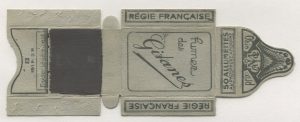
President’s Award and Members’ Award winner 2024
Exhibitor : Stephane Pinaud

Click here for French language version
The matchbox known as “Portefeuille” is a box format that dates back to the middle of the 19th century. The oldest one we know of is from the manufacturer Roche & Cie in Marseille and dates from 1848, but there were certainly older ones.
This box format existed in France in different sizes until the mid-1950s. This exhibit shows this beautiful history through a few examples from my collection.
Click here to return to the Gallery.
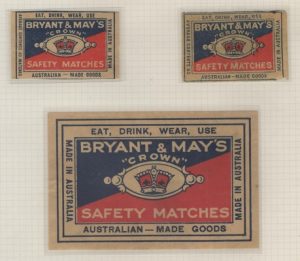
Committee’s Award winner 2024
Exhibitor : David Figg
During World War II, four of Australia’s match manufacturers issued box labels bearing patriotic war slogans and maxims. The firms were : Bryant & May (Melbourne), W. A. Match Co. (Perth), Federal Match Company (Sydney) and Duncan’s (also of Melbourne).
As well as the box size labels shown here, there was one dozen packet label issued by Bryant & May which encouraged the population to “Eat, Drink, Wear, Use – Australian Made Goods”.
Naturally, this was in the days when a box of matches contained 60 sticks, the box was made of wood instead of cardboard, and the product itself was also 100% made in Australia, a “striking” contrast to the situation today where all are now imported.
Click here to return to the Gallery.
Members’ Award winner 2021
Exhibitor : Jesús María Bollo García

Click here for Spanish language version

This is the story of an horrific murder which was committed in Madrid in 1888, and the famous trial which followed, as shown on contemporary matchboxes manufactured by Garay and Arregui who quickly spotted an opportunity to boost sales by using images of the protagonists on their boxes.
Note : single labels are shown below but unfortunately I do not have a complete box from this series. However, on the right is a card-outer label from a different series produced by Garay y Arregui in 1889.

It was 2:30 in the morning on the 2nd of July 1888 when the residents of 109 Calle de Fuencarral raised the alarm, after they heard shouting from the second floor flat followed by thick black smoke coming from a window. The police broke down the door and discovered the body of Doña Luciana Borcino de Varela lying dead in her bed, face up. She had been stabbed three times in the chest, and her body was wrapped in wet oily rags which had been set alight.
In the room next door they found her new maid servant, Higinia Balaguer Ostalé, lying unconscious on the floor lying next to a sedated bulldog.

Doña Luciana Borcino de Varela was a wealthy widow, 50 years old, who lived in the flat with her feckless son José Vázquez-Varela, 23 years old, who was always asking his mother for money. He was currently in the Cárcel Modelo prison for the third time after committing another misdemeanor. He had previously been in jail for hitting his own mother and on another occasion for slashing his girlfriend Dolores Gutiérrez with a razor. Doña Luciana was known as a strong, severe woman who had difficulty retaining servants – Higinia had only been with her for six days. The autopsy showed that one of the stab wounds had been fatal, and that she had been burned after she was dead.

The police arrested Higinia as the prime suspect and sent her to the Women’s Prison, although the motive for the crime was unclear. Higinia said that when she returned to the flat on the evening of 1st July Doña Luciana was with a man and they told her to go to bed, then when she woke up the flat was full of dense acrid smoke. In one of four different confessions she made Higinia accused José of committing the murder, saying that he had threatened her with violence and offered her money telling her to buy the petrol, clean up the blood and burn the body. But how could he have committed the murder when he was in prison ?

Higinia had arrived at Calle Fuencarral recommended by Sr. Millán Astray. He was the interim director of the Cárcel Modelo and had previously employed Higinia as his maid. It was also common knowledge that prisoners were able to leave the prison whenever they wanted to, and José had often been seen in the streets.
The Trial commenced on 26th March 1889, and was notable because it was the first time that “Acción Popular” was used in a Spanish court, allowing any Spanish citizen to appear as a witness even if they were not directly involved in the crime. The Newspaper Editors enthusiastically exercised this right, because they considered that the Trial was full of irregularities and suspected political motives in the background. The Newspapers started reporting court proceedings for the first time and this Trial was big news.
Higinia was the central character in the Trial, a good-looking illiterate girl of 28 years, who achieved a certain notoriety not only because of her ‘star performances’ in the dock but also because she changed her statement four times – from accepting sole responsibility for the murder to accusing others.

The prosecution decided that Higenia must have had help to commit the crime, and that her motive was robbery. She identified her friend Dolores Ávila (“Lola la Billetera”) as a collaborator and the actual murderer, but in her final testimony Higinia stated that José killed his mother, and that Sr. Millán had planned the crime, and they paid her generously for letting them into the flat. Also, records show that Sr. Millán spoke privately with Higinia in prison and also with Dolores after she had been incarcerated, both of which were highly irregular.
Many aspects of the case remained unexplained – where was the murder weapon, how was the dog tranquilized, and whose were the five cigarette butts on the floor near the body (Higinia didn’t smoke) ?
The Trial concluded on 29th May 1889, with a verdict of Guilty of Murder and Robbery. The judge sentenced Higinia to death by Garrote Vil, Dolores to 18 years in prison as accomplice and absolved José and Sr Millán of any blame. There was a massive public outcry at the verdict, but it was upheld.
Higinia was executed on 19th June in front of 20,000 people – this was the last public execution to be held in Spain. Just before the executioner applied the garrote Higinia cried out “¡Dolores, 14000 duros!” Soon after, Sr. Millán stepped down from his post, as did the President of the Supreme Court.
This famous case has been made into a film and a TV series, a play, many books and articles have been written about it, and it continues to intrigue criminology students many of whom see it as a huge miscarriage of justice where the rich get away with the crime and the servants take the blame.
Here are more labels with images of other actors in the Trial, click on an image to enlarge it.
[Not a valid template]Click here to return to the Gallery.
Our friends at the Rathkamp Matchcover Society have announced the dates of this year’s Convention : 14th to 21st August 2022 at the Doubletree Westlake, 1100 Crocker Rd., Westlake, OH 44145. RMS is celebrating its 80th year in 2022.
Full details of the Convention can be found on their web site
The August magazine has now been posted to members, which includes all the latest information about Phillumeny, all Society Events and the forthcoming Society Auctions.


Committee’s Award winner 2021
Exhibitor : Takeshi Yokomizo

Click here for Japanese language version
From olden days until recently, Japanese houses were mostly built from wood. When towns and cities developed and wooden houses were built densely, fire became an especially big hazard. Wooden constructions prompted fire to spread quickly and people constantly suffered from many conflagrations throughout history. The fear of fire disaster and the importance of awareness of fire prevention were shared by people and communities throughout the country.
“Hi-no-Yojin” was, and still is a popular fire prevention slogan (in English this means “Watch out the fire”). Boxes of matches carrying this slogan started appearing in the early Showa-era (the late 1920’s till early 1940’s), and played a big part in raising people’s awareness of the danger.
The production of advertisement-matches burgeoned in the early Showa-era. Most match factories in Japan were of a relatively small scale and able to accept small orders for local clients. These labels became a good advertising medium for campaigning about fire prevention on a community basis. Some of these fire-prevention match labels featured equipment and symbolic objects relating to fire-fighting.
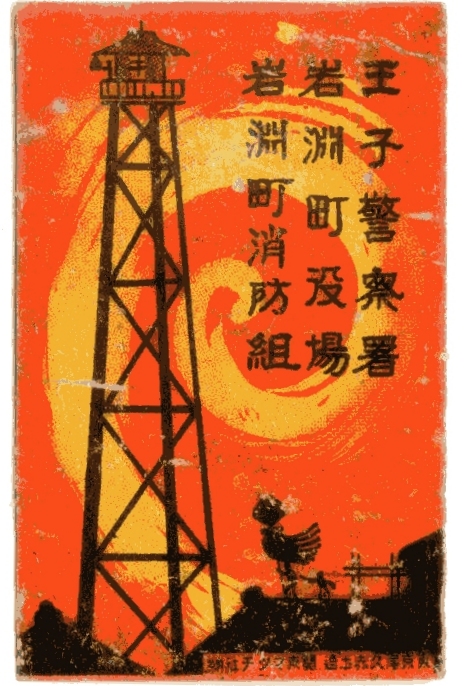
From the early 1920’s till 1960’s, fire watch-towers made of an iron framework were installed in every fire station.
A fire watch-ladder together with a fire-pump house were deployed to community-based volunteer fire companies (about 2,400 of them nationwide).
The fire watch-ladder played a key role in raising the alarm by ringing a fire-bell attached to the top of the tower. However, most watch-towers and watch-ladders fell into disuse as houses and buildings became taller.
Night-Watch for fire prevention in the winter started in 1648, in the Edo period. During the winter, a group of locals patrolled their neighbourhood area at night. They struck clappers and called out “Watch out the fire. A single match causes a fire!” while walking. Night-watch has been one of the seasonal traditions in Japan but complaints about the noise of the clapper increased and became an issue.
In the 18th century, the first official fire-company was formed in the capital Edo (Tokyo). It consisted of 48 regional and 16 capital brigades.
Matoi represented each brigade and were used like a flag. Fire-fighters rushed to the site and placed Matoi at the top of the roof showing local people their presence. The 48 regional brigades were mostly identified by the old Japanese alphabet (48 in total) like, “E-brigade, Ro-brigade, Ha-brigade…”.
The installation of fire-alarms in urban areas started in 1920. Modern fire extinguishers were distributed widely but fire-extinguishing buckets are still regularly installed as a basic fire extinguishing tool. The top cause for fire in the capital Tokyo has been careless smoking.
More Fire Prevention labels from the early Showa-era are shown in the gallery below, click on an image to enlarge it.
[Not a valid template]Click here to return to the Gallery.
We’re pleased to announce that the Kidlington meeting will be back in 2023 after its absence due to Covid.
It will take place on Sunday January 15th 2023 from 09:00 to 15:00.
More details can be found here.
On 5th July 2022 a Blue Plaque was unveiled in Bow, London, commemorating the famous Match Girls strike of 1888.
Full details of the unveiling, and the campaign to remember this landmark 19th century event, can be found on The Matchgirls Memorial website.

The Bangladesh Matchbox Collectors’ Club (BMCC) have announced that they will hold their third international virtual Matchbox and Labels Exhibition from 1st to 15th January 2023, and they are encouraging collectors to contribute. The theme for the Exhibition is : Life on matchboxes & labels.
Full details of how to participate can be found on their web site here. The last date for submissions is 20th December 2022
The October magazine has now been posted to members, which includes all the latest information about Phillumeny, all Society Events and the forthcoming Society Auctions.
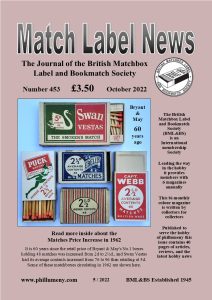
The April magazine has now been posted to members, which includes all the latest information about Phillumeny, all Society Events and the forthcoming Society Auctions.

The February magazine has now been posted to members, which includes all the latest information about Phillumeny, all Society Events and the forthcoming Society Auctions.
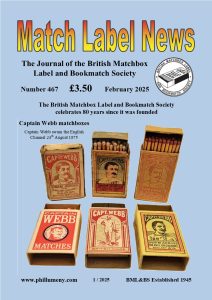
Here is our Exhibition Catalogue. The Exhibits are listed in alphabetical order, click on a link below to access an Exhibit or read an Exhibitor’s biography. An asterisk indicates that the Exhibit is available in dual language.
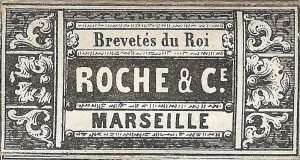
Members’ Award winner 2023
Exhibitor : Stéphane Pinaud

Click here for French language version
The French production in the 19th century is known for very beautiful lithographed boxes and very varied shapes. These pictorial attractions have meant that they have been preserved (completed or cut-panel) and, in fact, we know many of them.
Early manufacturers used much cruder labels and boxes that are much harder to find. What could encourage a person to keep such boxes and labels ? Almost nothing, and I find incredible that such objects have reached us.
So here are some rudimentary labels and boxes from the 1830s to the early 1870s and the establishment of the monopoly. Some manufacturers have chosen to use these boxes and labels until the establishment of the monopoly, probably for cost reasons.
Click here to return to the Gallery.
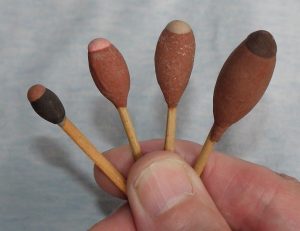
President’s Award winner 2023
Exhibitor : Phil Stringer
Many companies produced “Cigar Lights” on a simple wooden splint. The example on the left in the photo is a Bryant and May light of standard size, with bigger examples, that on the far right would take a brave smoker to hold this while it burned.
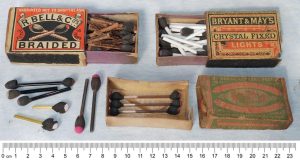
The need, or a perceived need, to protect against the burning head from dropping off, meant that various ideas were tried, one of the most popular was to incorporate wires along the stem held by cotton braids, the “Braided Cigar Light”.
Another way to ensure the head didn’t drop was a non-combustible stem, Glass, porcelain, Letchford even used bone as a solution. The steel stemmed examples are probably experimental pieces and would likely become too hot to hold.
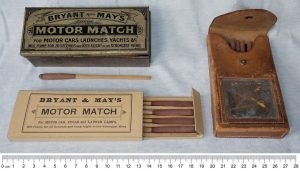
The Motor Match, basically four times the size of a regular windproof match, if blown out it would reignite. Sold in card packets of ten or larger tins of fifty, bespoke holders of metal or leather, as shown, were available.

Another match specifically designed for the motorist was the Three Stars Gengas Match. This was used in Sweden during WW2 to ignite the engine of a gas-powered car, developed to assuage petrol shortages.

The Merx Fusee was used by the telegraph industry, designed to light a magnesium tablet for a portable soldering iron. The examples in the cylindrical tin had a metal tube with solder inside and a match type composition around the exterior, the two ends of a wire would be pushed into the tube and the outer lit by a supplied match.
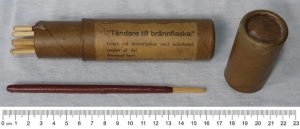
Tandare Till Brannflasker, translates to read as “Molotov Cocktail Match”. Dated to 1943 they were intended for use during WW2, attached to Tandare Till Brannflaskera petrol bomb the ignited match would inflame the contents when broken.
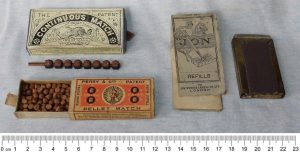
Pellet matches, different means of igniting these were employed, Perry’s lights fitted into a metal device of two tubes either side of a central plunger, this when pushed down would ignite a single pellet. The Jon Wonder held the pellets in a case, a separate tweezer like device would grip a single pellet to be struck like a conventional match. The Continuous Match (facsimile box) worked on a similar principal to the perry with a container that would ignite each head in succession.

The Drown and Co Ignition Rod functioned in the same way as a conventional match except it could be blown out and reused until spent.
Center top a Swedish example the others experimental versions.
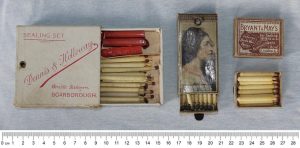
The candle wax vesta was very similar in size and appearance to a birthday cake candle with a match head composition. The box was designed to hold the match to facilitate the melting of sealing wax.
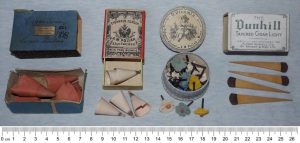
Cigar Caps fitted over the cigar end, the tips were pushed in then the cigar itself struck like a match. The tips shown here are by Pollock and had cloth flowers to decorate the heads. The sharp end of the Dunlop was used to pierce the cigar but not left in as the tips were.
Click here to return to the Gallery.

Members’ Award winner 2022
Exhibitor : Anthony Harris
Welcome to my Matchstick garage (Bryant & May Woodcraft kit, distributed in the 1980’s, but put together more recently). To give you an idea of the size of my garage the double doors are 4.5cms high.
It is Friday today and it will be a busy day. Please join me for this day in my life.
I am the garage proprietor and I have three employees :
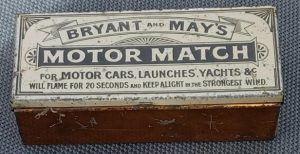
As I mentioned we all have a busy day ahead.
The four of us are in the garage this morning and then off to a racing circuit this afternoon and then the rest of the weekend providing mechanic support.
I need to get a motor on and ensure I and the team perform in all conditions.
I wish to show you some of the jobs which I and the team need to be complete at the garage this morning.
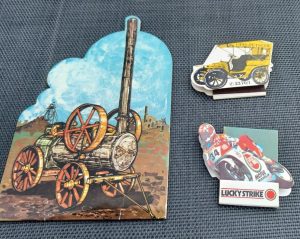
They are unusual quirky matchbook shaped items that appeal to me :
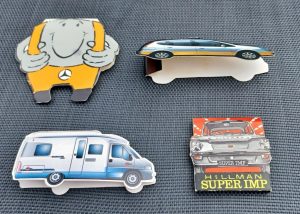

Two Trucks (which are match book containers) have arrived in time with the parts and accessories that we need to complete this morning’s jobs.
The deliveries thankfully included the anti-freeze (or Ethylene Glycol) from Shell. The can is plastic capped, made in Holland and is 5.5 cm’s tall and a diameter of 3.8 cm’s. More than enough to fill the Super Imp. Now time for a brew, the biscuits are in this Ian Logan Associates Limited Queens Silver Jubilee 1977 bus tin (the tin was based on an original design of Huntley and Palmers produced in the early 1900’s.). Tea drunk and empty mugs placed on the tray ready for washing up. The tray shows Bryant & May advertising on the side of a tram and is otherwise unmarked with a diameter of 30.5 cm’s and depth of 2.5 cm’s.

U-Haul (also trade-marked as Mom’s Attic), claims to be the “Number one family mover” send their “Van that rides on air” to pick up the Lucky Strike Motorbike. The service has been completed in time.
Payment can be made through the slot in the roof now that all the U-Haul matchbooks have been removed. The back and the front both open. Manufactured by U Haul in 1988. 21 cm’s long.
It is now the end of the morning, and I am delighted that we have got all the work done.
I have hooked up the caravan to my time travelling car (gripping stuff!) and we are all off to an American racing circuit where we are on duty as race mechanics for the Smokin’ Joe’s race team.
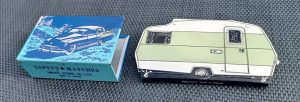
The Caravan came “with the compliments of Sprite Caravans, it contains 10 yellow headed matches and is marked as a Finnovision made in Finland. The car is marked on the spine “Safety Matches Smoke Stone Co Ltd Made in Japan”. On the reverse is the question “Will Your Car start Tomorrow?” I hope it does! Standard size 6 x 4 2 cm’s, but big enough to tow the caravan safely!
Smokin’ Joe’s is a US (Headquarters in New York) Tobacco and Cigar Brand that also operates trading posts and a chain of smoking stores. They have brought two vehicle transporters to the race circuit.
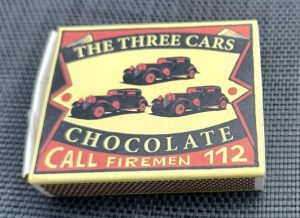
What a performance the drivers put on with some great qualifying lap times achieved, all going so well ahead of racing tomorrow, so time to celebrate with some bubbly and chocolate (lots to go around from this box which measures 7.3 x 6.2 x 1.8 cm’s)!
What a great day. Time to go to sleep in the caravan. Thank you for visiting the garage and joining me racing. I hope we can do it all again soon.
Click here to return to the Gallery.

Committee’s Award winner 2022
Exhibitor : Jesús María Bollo García

Click here for Spanish language version
When a Phillumenist comes across a 19th century scrapbook album they have in their hands a real treasure chest for two reasons : on the one hand it contains many matchbox labels that are not usually found in the shops or in auctions, and, in addition, an opportunity to spend many hours enhancing their own collections while looking through the beautiful scrapbook.
The most elaborate scrapbook albums (and therefore the real treasures) feature covers either of leather or other materials with sewn and well-bound pages, like the one below.
[Not a valid template]In order to understand how and why these scrapbook albums appear we need to go back to the time when they were made : a world completely different from our current one, in which there was neither light, nor leisure, nor universal free education, nor a living wage, etc. etc.

We need to bear in mind that in the late 19th Century children and young people began working at a very early age and with schedules that would be considered completely unacceptable today (just look at the photos that exist, for example; of the workers of the Pascasio Lizarbe Factory, mostly young girls). A high percentage of the population was illiterate and families had few belongings, with little time to devote to leisure (in Spain the Sunday rest day wasn’t implemented until 3rd June 1904). The typical workday was 14 to 16 hours a day, which was logically not really a stimulus to devote time and money to creating a scrapbook album of matchbox labels.
My conclusion therefore is that the people who made these albums must have come from families of a medium or high status, because they needed money and they needed time for such a detailed artisan undertaking.
There are many different examples of scrapbook albums, but they all start with large sheets of paper or card onto which the labels are glued. Sometimes the labels were laid out in order and sometimes just as they were acquired rows, like these :
[Not a valid template]But often the “Phillumenist” used their own imagination to enhance the collection by incorporating other items of common “ephemera” such as die-cut cards, prints, chocolate cards. And sometimes they would add their own pen-and-ink drawings :
[Not a valid template]The creativity, skill and attention to detail of the maker was almost limitless, as these examples show :
[Not a valid template]As you can see from the first to the last photo the treasure contained in any scrapbook album speaks for itself.
Good luck searching, and I hope you also find your own treasure.
Click here to return to the Gallery.
We are delighted to announce the Award winners from our 2022 On-line Phillumeny Exhibition :
These three Exhibits are now in the Permanent Gallery.
We will be holding another On-line Phillumeny Exhibition in October 2023.
If you have any questions about the Exhibition then please contact us at onlineexhibition@phillumeny.com
On 7th November 2022 the Reuters news agency reported that Philip Morris has been successful in its bid to buy Swedish Match. Their declared intention is to take Swedish Match private.
We are very sorry for the delayed receipt of the December issue of “Match Label News”. It was posted on 2nd December and has been caught up in the current strikes by Royal Mail.
The Associação Portuguesa de Filumenismo (APF) organised an on-line exhibition to celebrate its 50-year anniversary. The Show opened on 3st July 2022 and has been extended to the end of January 2023. You can visit the Exhibition here
The Bangladesh Matchbox Collectors Club (BMCC) have organised their third annual on-line exhibition which can be viewed here from 1st to 15th January 2023.

The October 2025 magazine has now been posted to members. It includes full details of the Society Auctions and all the latest phillumeny news.
